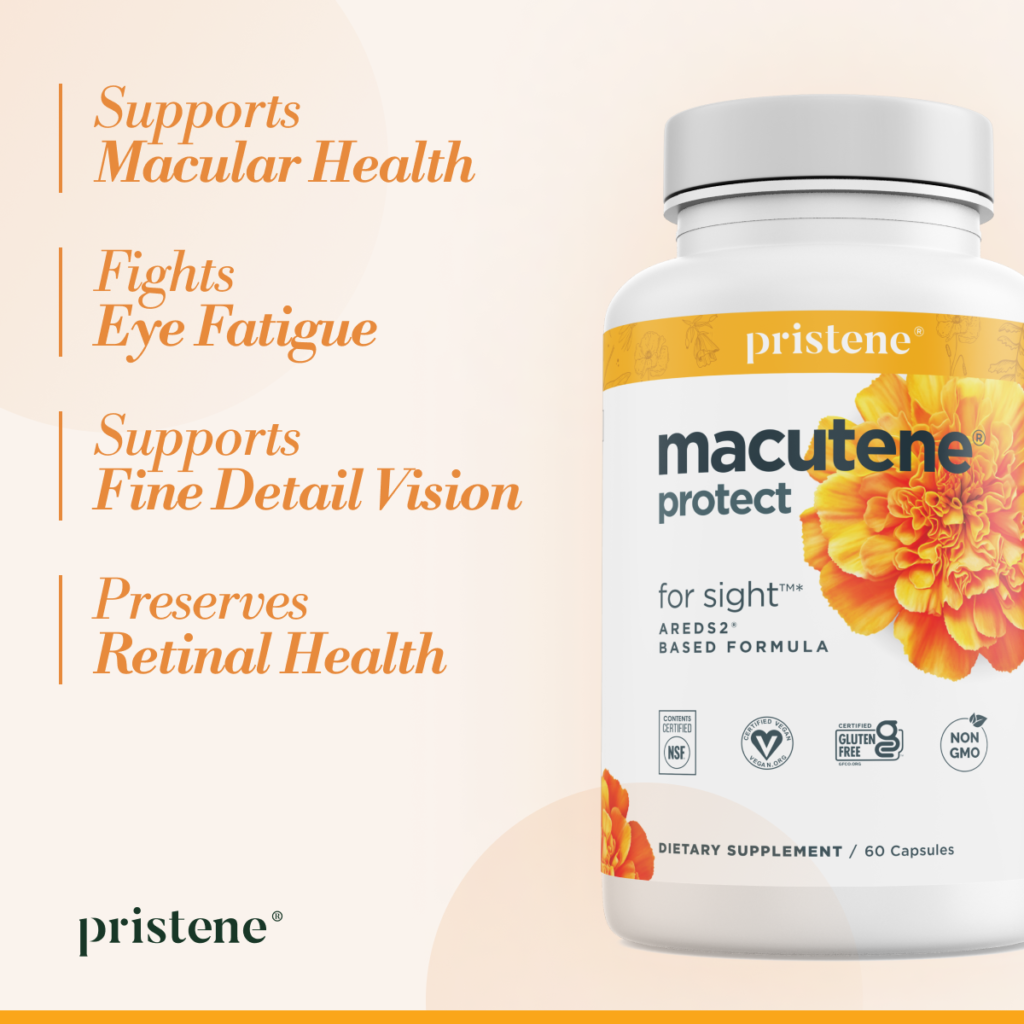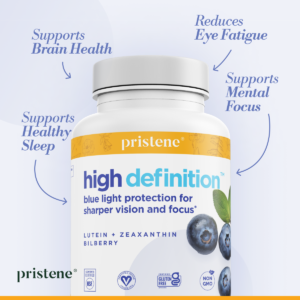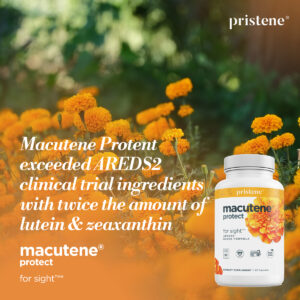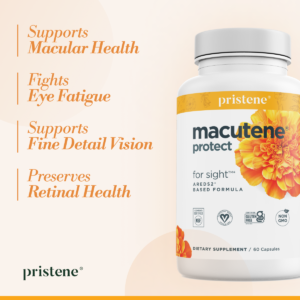To maintain macular health from the natural effects of aging on eyes, The American Academy of Ophthalmology recommends that in order to prevent or delay advanced AMD, people should include nutritional supplements that include antioxidants and also eat a healthy, balanced diet that includes dark leafy greens (like spinach and kale) along with yellow, orange and other colorful fruits and vegetables.
The macula is the central part of the retina, located at the back of our eye. It is responsible for fine, detailed, central vision and its layers are densely packed with light-sensitive cells (photoreceptors, rods and cones) that transmit nerve impulses through the optic nerve to the brain, where a visual image is formed. Electrochemical transmission of light is how we see.
Retinal photoreceptors, and more specifically the fovea is subjected to oxidative stress throughout our lifetime. Oxidative stress or oxidative damage occurs during the chemical reaction of oxygen with DNA, proteins and lipids.
Harmful and unstable free radicals of oxygen and nitrogen cause damage to healthy cells as these paramagnetic entities move through the body in search of an electron to make them more stable. Research has shown that the damage caused by oxygen and free radicals can lead to increased risk of cancer, heart disease, and eye disease.
We are constantly forming free radicals as a normal part of aging, and we increase production of them when we are exposed to harmful environmental challenges from air pollution, pesticides, cigarette smoke, “electromagnetic smog” and solar ultraviolet rays.
Antioxidants and Effects on Macular Health
Antioxidants can stop the cycle of free radical damage by donating an electron to the free radical, neutralizing it, and preventing it from causing further damage. Some antioxidants are produced by your body (endogenous), but some are not (exogenous). As we age, the body’s natural antioxidant production declines, so it is important to consume enough.
The macula is highly sensitive to free radicals and oxidative stress. The macula unfortunately degenerates with age and in some people this process of deterioration is accelerated. This is known as age-related macular degeneration (AMD). As AMD progresses, it can lead to either loss of photoreceptors, known as geographic atrophy, or damaging new blood vessels that can grow, leak fluid, and scar.
The former is known as dry AMD and the latter is known as neovascular or wet AMD. Antioxidants prevent cellular damage to photoreceptors by reacting with, and deactivating free radicals. They protect against the deterioration of the macula, which leads to devastating vision loss.
The American Academy of Ophthalmology recommends that in order to prevent or delay advanced AMD, people should eat a balanced diet that includes dark leafy greens (like spinach and kale) along with yellow, orange and other colorful fruits and vegetables. Nutritional eye supplements, such as Macutene Protect by Pristene, can play a key role in providing these exogenous antioxidants and minerals.
Top 7 Antioxidants to Support Macular Health:
#1 & #2: LUTEIN & ZEAXANTHIN – THE EYE CAROTENOIDS
Approximately 700 different carotenoids have been identified in nature. Between 20 and 30 are found in the human body, but lutein and zeaxanthin are the only carotenoids found in the eye. Carotenoids are pigments that help protect plants from oxidative damage and are incredibly efficient nonenzymatic antioxidants. They help convert free radicals into their nontoxic forms, interrupting the free radical chain reactions that cause cell damage. Carotenoids classified as small-molecule antioxidants work by collecting and neutralizing oxygen and reactive oxygen free radical molecules.
The accumulation of lutein and zeaxanthin at the macula creates macular pigments which is what gives the macula its yellow appearance. As in plants, lutein and zeaxanthin, act as filters of damaging high energy blue light, protecting macular health. Lutein and zeaxanthin clearly benefit eye health. These pigments are the focus of numerous studies and clinical trials, particularly relating to their use in improving visual function, and reducing the risk and slow progression of AMD as well as cataracts. There have also been encouraging results in the use of lutein and zeaxanthin in diabetic retinopathy and retinopathy of prematurity. [5]
Lutein and Zeaxanthin are part of a subgroup of carotenoids, called Xanthophylls. Zeaxanthin is the most common carotenoid that exists naturally and is found in food like peppers, kiwi fruit, maize, grapes, squash and oranges.
#3 QUERCETIN
Quercetin is a type of flavanol, known for dampening inflammation, promoting healthy blood vessel function and removing age associated cellular debris. Its’ found in, red onions, apples, peppers, grapes, red wine, black tea, green tea, leafy vegetables, broccoli and some fruit juices. Research studies have reported quercetin to have excellent antioxidative, anti-inflammatory, and anti-proliferative capabilities. Studies specific to retinal and macular health have shown that quercetin can protect precious retinal pigment epithelial cells. Most recently, research has shown that quercetin suppresses VEGF-induced excessive inflammatory response in retinal photoreceptor cells, which is incredibly important for treatment of retinal diseases caused by excessive VEGF. [3]
Quercetin is known for promoting healthy blood vessel function, and having excellent antioxidative, anti-inflammatory, and anti-proliferative capabilities.
#4 EPIGALLOCATECHIN GALLATE (EGCG)
Epigallocatechin gallate (EGCG) – A catechin polyphenol, is the most abundant and most powerful antioxidant found in green tea. Beyond green tea, it is also one of the most powerful antioxidants known today. In addition to supporting macular health, EGCG has been shown to help lower the risk of heart attack, stroke, glaucoma, and high cholesterol. [1] As well, studies have shown that it may benefit exercise performance, and regulate fat metabolism. [2] Studies have shown EGCG effectively reduces retinal cell death due to oxidative stress from UVB light, providing protection to photoreceptor cells from retinal degeneration. [7]
Epigallocatechin gallate supports macular health and lowers risk of glaucoma, high cholesterol, heart attack, and stroke.
#5 BILBERRY & ANTHOCYANINS
Bilberry is part of a group of compounds called anthocyanins, which have powerful antioxidant and anti-inflammatory action. Bilberry has 15 anthocyanins, derived from anthocyanins, the pigments that determine the red, blue and violet colors of flowers and fruits. In plants, anthocyanins have been shown to protect cells from photo-damage by absorbing blue-green light, thereby protecting the cells from high light stress. When ingested by humans, these compounds have the same effects on our cells. Research has shown that anthocyanin-rich bilberry extract may have the ability to inhibit multiple biological pathways in the retina to protect visual function. [4] Increased levels of antioxidant defense suppress the chemical reactions that cause inflammation, reducing the occurrence of retinal cell death, thus having a tissue-protecting effect. [6]
#6 VITAMIN C
Vitamin C is a nonenzymatic antioxidant that helps convert free radicals into their nontoxic forms preventing cell damage.
Vitamin C – An essential micronutrient for humans and for macular health. Vitamin C is a monosaccharide antioxidant obtained from both animals and plants. It is a simple extracellular nonenzymatic antioxidant that helps to convert free radicals into their nontoxic forms, interrupting free radical chain reactions that cause cell damage. Vitamin C also falls into the category of small-molecule antioxidants that work by hunting, collecting and then carrying away the reactive oxygen molecules through a process of neutralization.
#7 VITAMIN E
Vitamin E converts free radicals into nontoxic forms and interrupts free radical chain reactions that cause cell damage.
Vitamin E – is a nonenzymatic cellular membrane bound antioxidant that helps to convert free radicals into their nontoxic forms, interrupting the free radical chain reactions that cause cell damage. Like Vitamin C and the carotenoids, Vitamin E also falls into the category of small-molecule antioxidants that work by hunting, collecting and then carrying away the reactive oxygen molecules through a process of neutralization.
Naturally sourced Vitamin E includes a family of eight different compounds (four tocopherols and four tocotrienols). Make sure you are getting all these Vitamin E compounds from a healthy, balanced diet or naturally sourced supplement. It is important to know that a supplement with a synthetic source, may only include one of the eight compounds.
A Better Nature-Based AREDS2 Formula with More Lutein & Zeaxanthin and Additional Clinically Proven Ingredients for Optimal Macular Health.


References
[1] Falsini B, Marangoni D, Salgarello T, Stifano G, Montrone L, Di Landro S, Guccione L, Balestrazzi E, Colotto A. Effect of epigallocatechin-gallate on inner retinal function in ocular hypertension and glaucoma: a short-term study by pattern electroretinogram. Graefes Arch Clin Exp Ophthalmol. 2009 Sep;247(9):1223-33. https://www.ncbi.nlm.nih.gov/pubmed/19290537
[2] Hodgson AB, Randell RK, Jeukendrup AE. The Effect of Green Tea Extract on Fat Oxidation at Rest and during Exercise: Evidence of Efficacy and Proposed Mechanisms. Adv Nutr. 2013 Mar; 4(2): 129–140. https://www.ncbi.nlm.nih.gov/pubmed/23493529
[3] Lee M, Yun S, Lee H, Yang J4. Quercetin Mitigates Inflammatory Responses Induced by Vascular Endothelial Growth Factor in Mouse Retinal Photoreceptor Cells through Suppression of Nuclear Factor Kappa B. Int J Mol Sci. 2017 Nov 22;18(11). https://www.ncbi.nlm.nih.gov/pubmed/29165402
[4] Miyake S, Takahashi N, Sasaki M, Kobayashi S, Tsubota K, Ozawa Y. Vision preservation during retinal inflammation by anthocyanin-rich bilberry extract: cellular and molecular mechanism. Lab Invest. 2012;92:102–9. https://www.ncbi.nlm.nih.gov/pubmed/21894150
[5] Scripsema NK, Hu DN, Rosen RB. Lutein, Zeaxanthin, and meso-Zeaxanthin in the Clinical Management of Eye Disease. J Ophthalmol. 2015;2015:865179. https://www.ncbi.nlm.nih.gov/pubmed/26819755
[6] Wang Y, Zhao L, Lu F, Yang X, Deng Q, Ji B, Huang F. Retinoprotective Effects of Bilberry Anthocyanins via Antioxidant, Anti-Inflammatory, and Anti-Apoptotic Mechanisms in a Visible Light-Induced Retinal Degeneration Model in Pigmented Rabbits. Molecules. 2015 Dec 14;20(12):22395-410. https://www.ncbi.nlm.nih.gov/pubmed/26694327
[7] Yang Y, Qin YJ, Yip YW, Chan KP, Chu KO, Chu WK, Ng TK, Pang CP, Chan SO. Green tea catechins are potent antioxidants that ameliorate sodium iodate-induced retinal degeneration in rats. Sci Rep. 2016 Jul 7;6:29546. https://www.ncbi.nlm.nih.gov/pubmed/27383468








